Women in punk rock
Women have made significant contributions to punk rock music and its subculture since its inception in the 1970s.[1][2] In contrast to the rock music and heavy metal scenes of the 1970s, which were dominated by men, the anarchic, counter-cultural mindset of the punk scene in mid-and-late 1970s encouraged women to participate. This participation played a role in the historical development of punk music, especially in the US and UK at that time, and continues to influence and enable future generations.[3] Women have participated in the punk scene as lead singers, instrumentalists, as all-female bands, zine contributors and fashion designers.[4]


Rock historian Helen Reddington wrote that the popular image of young punk women musicians as focused on the fashion aspects of the scene (Fishnet stockings, spiky hair, etc.) was stereotypical. She states that many, if not all women punks were more interested in the ideology and socio-political implications, rather than the fashion.[5][6] Music historian Caroline Coon contends that before punk, women in rock music were virtually invisible; in contrast, in punk, she argues, "It would be possible to write the whole history of punk music without mentioning any male bands at all – and I think a lot of [people] would find that very surprising."[7][8]
Johnny Rotten wrote that "During the Pistols era, women were out there playing with the men, taking us on in equal terms ... It wasn’t combative, but compatible."[9] Chrissie Hynde echoed similar sentiments when discussing her start in the punk scene, "That was the beauty of the punk thing: sexual discrimination didn't exist in that scene."[10] The anti-establishment stance of punk opened the space for women who were treated like outsiders in a male-dominated industry. Sonic Youth's Kim Gordon states, "I think women are natural anarchists, because you're always operating in a male framework."[11] Others take issue with the notion of equal recognition, such as guitarist Viv Albertine, who stated that "the A&R men, the bouncers, the sound mixers, no one took us seriously. So, no, we got no respect anywhere we went. People just didn't want us around."[12][13]
History
Context
Musicologist Caroline Polk O'Meara has written that female experience, feminism and taking a pro-woman stance empowered women's participation in punk rock beginning in the 1970s.[14] In popular music, there has been a gendered "distinction between public (male) and private (female) participation" in music.[15] "[S]everal scholars have argued that men exclude women from bands or from the bands' rehearsals, recordings, performances, and other social activities."[16] "Women are mainly regarded as passive and private consumers of allegedly slick, prefabricated – hence, inferior – pop music..., excluding them from participating as high status rock musicians."[16] One of the reasons that mixed gender bands were traditionally rare was that "bands operate as tight-knit units in which homosocial solidarity – social bonds between people of the same sex... – plays a crucial role."[16] In the 1960s pop music scene, "[s]inging was sometimes an acceptable pastime for a girl, but playing an instrument...simply wasn't done."[17] Punk is more of a subculture than a widely popular genre of music, which is why women may have been drawn to it beginning in the late 1970s.
In the UK, the Sex Discrimination Act of 1975 allowed women the same access to jobs as men. Some men thought that this legislation put them at a loss and felt that women were taking away positions that traditionally belonged to men. This, and the election of Margaret Thatcher, led many young women who felt disenfranchised to the up-and-coming punk rock music scene. Artists like Suzi Quatro are considered to be major influences in the early British punk culture. Quatro refused to be sexualized by the media and indirectly dealt with the issue of sexism by embracing a tough, rocker persona while producing music that could thrive in the mainstream. Bands like X-Ray Spex and The Slits took this feminist rock culture and combined it with a more two-fisted style of music.[4] This genre reflected on social, cultural and political changes of the United Kingdom at the time,[5] and continued to do so in other locations.
In the US, women such as Exene Cervenka and Joan Jett made contributions to the Los Angeles punk scene in the late 1970s and early 1980s. Cervenka's aggressive style and her non-conventional looks drew more young women to the scene since it was inclusive.[18] Many of these women sought to fight public sexual harassment and encourage body positive attitudes through their music. Leather jackets, short skirts, fishnets and choker necklaces were part of the punk style and culture. This style made many punk women targets for sexual harassment in the streets. They often spent much time outside waiting for shows, smoking, and meeting with one another, which created a kind of vulnerability. Women punk musicians retaliated by educating the young girls involved in the scene, taking legal action, and writing songs on the matter.[19] While punk in New York City and San Francisco emerged in the 1970s, the Los Angeles scene was arguably at its strongest point in the eighties, as a response to the conservative push for a more moral America by Ronald Reagan's administration. Mainstream rock such as Christopher Cross or Hall and Oates did not tend to address political issues, which left a space for rebels like Joan Jett and Blondie within the charts.[4]
The feminist ideologies of punk rock in the 1970s and 1980s[19][5] persevered into the 1990s via the Riot grrrl movement in the Washington, D.C. area. Riot Grrrl addressed more than the sexism of punk culture alone. Rather, the movement applied feminism on a broader scale by taking on issues such as sexual assault, systematic sexism, and the idea that sex is taboo for women. Riot Grrrl began by primarily using homemade magazines, known as zines, and group meetings. Eventually, the movement developed into a genre of music that was more aggressive than the mainstream rock of the decade. This genre reflected the same values as the zines. It was within this era that the LGBT community began to use punk rock as an outlet for advocacy as well. Groups from the early 21st century such as Pussy Riot and Panty Raiders combine feminist and queer values in their music and films.[19]
The constant push for gender equality over three decades has resulted in a more inclusive punk rock culture that is no longer divided by sex. No Doubt is one example of this accepting culture. They are a co-ed musical group with a female singer who addresses feminist issues. One of No Doubt's songs, "Just a Girl", made it to the Billboard Hot 100, peaking at number 23 back in 1995. Sleater-Kinney and Le Tigre are groups known to mix feminist ideologies with other social justice themes. Following George W. Bush's administration's response to tragedies like Hurricane Katrina and 9/11, these female-headed groups offered political criticism through politicized songs. Sleater-Kenny's song, "Combat Rock," was anti-war in nature and directly criticized the U.S. government's decisions regarding the Middle East.[20]
"The rebellion of rock music was largely a male rebellion; the women—often, in the 1950s and '60s, girls in their teens—in rock usually sang songs as personæ utterly dependent on their macho boyfriends...". Philip Auslander says that "Although there were many women in rock by the late 1960s, most performed only as singers, a traditionally feminine position in popular music". Though some women played instruments in American all-female garage rock bands, none of these bands achieved more than regional success. So they "did not provide viable templates for women's on-going participation in rock".[21]:2–3 In relation to the gender composition of heavy metal bands, it has been said that "[h]eavy metal performers are almost exclusively male"[22] "...[a]t least until the mid-1980s"[23] apart from "...exceptions such as Girlschool."[22] However, "...now [in the 2010s] maybe more than ever–strong metal women have put up their dukes and got down to it",[24] "carv[ing] out a considerable place for [them]selves."[25]
When Suzi Quatro emerged in 1973, "no other prominent female musician worked in rock simultaneously as a singer, instrumentalist, songwriter, and bandleader".[21]:2 According to Auslander, she was "kicking down the male door in rock and roll and proving that a female musician ... and this is a point I am extremely concerned about ... could play as well if not better than the boys".[21]:3
Patti Smith
.jpg.webp)
Patti Smith (born 1946) is a groundbreaking New York City punk rock singer-songwriter, poet and artist, whose first album, Horses (1975), significantly influenced the New York City punk rock genre. Smith's work went on to receive international recognition. In 2007 she was inducted into the Rock and Roll Hall of Fame.[26] She was born Patricia Lee Smith in Chicago, Illinois, U.S.[27]
Chrissie Hynde

Chrissie Hynde (born 1951 in Akron, OH) is a singer, songwriter and guitar player and co-founder of the band, The Pretenders.[28] They were inducted into the Rock and Roll Hall of Fame in 2005.
Siouxsie Sioux
Born Susan Janet Ballion in 1957 in Southwark, England, Siouxsie Sioux is best known as the lead singer of Siouxsie and the Banshees, releasing eleven studio albums. She continued to tour with The Creatures before embarking on a solo career.[29]
Nina Hagen

Catharina Hagen (born 1955), known as the German singer, Nina Hagen, was born in East Berlin, German Democratic Republic. After she emigrated to West-Berlin in 1976, she joined the band Spliff, and together they named themselves Nina Hagen Band. They released 2 studio-albums, Nina Hagen Band and Unbehagen. She left the band in 1979 and became a solo artist, and released her first solo album NunSexMonkRock in 1982.[30] This was followed by the 1983 album, Fearless and in 1985, In Ekstasy.[31]
Exene Cervenka

Exene Cervenka co-founded the band X in 1977, with John Doe, Billy Zoom and DJ Bonebrake. Their album, Los Angeles (1980) established her as a presence as a powerful vocalist in the punk rock movement.[32]
Joan Jett
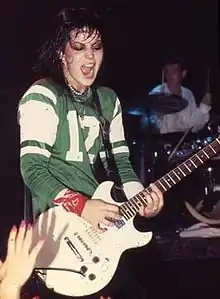
Joan Jett, born Joan Marie Larkin, and her all-female band, The Runaways was started when she was still in high school, and had several hits such as Cherry Bomb and American Nights. In the 1980s she founded her own independent label, Blackheart Records.[33] She was inducted into the Rock and Roll Hall of Fame in 2015.
Lydia Lunch
Lydia Lunch, began her career as the frontwoman for the band, Teenage Jesus and the Jerks, and went on to collaborate with numerous other musicians and bands, including Nick Cave, Sonic Youth, Brian Eno, among others.[34]
Poly Styrene
Poly Styrene (1957–2011) founded the punk band X-Ray Spex, whose 1978 album, Germ Free Adolescents established her as a strong contributor as front woman, singer-songwriter and musician.[35]
Ari Up
Ari Up (1962–2010), was born Ariane Daniela Forster in Munich, Germany, and was a vocalist and member of The Slits, a British punk rock band. She was only 14 years old she became The Slits' frontwoman in 1976, and was known as the most flamboyant and eccentric member of the group. She took guitar lessons from Joe Strummer of The Clash.[36][37]
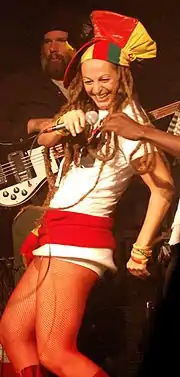
Gaye Advert
British born Gaye Advert, also known as Gaye Black, was the bass player for The Adverts. She has been called, "one of punk's first female icons", and the "first fema[le] punk star."[38][39]
Palmolive
Paloma McLardy (born 1955) is known as the drummer and songwriter for The Slits, as Palmolive. Born in Spain, she moved to London in 1972 to live in the squats with other counter-cultural youths.[40] In London, she befriended Joe Strummer of The Clash who introduced her to Sid Vicious, bass player for the Sex Pistols. Through these alliances she joined the band The Flowers of Romance with guitarist Viv Albertine. Having met 14-year-old Ari Up at a Patti Smith concert, they formed the all-women punk band, The Slits, playing gigs with The Clash, the Sex Pistols, the Buzzcocks, and others. In 1979, she joined the all female punk band, The Raincoats who recorded an album for Rough Trade Records.[41]
Poison Ivy
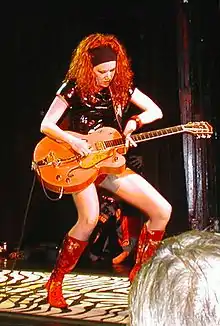
Poison Ivy (born 1953) is Californian who is known for her work as a guitarist and songwriter who co-founded the American punk-rockabilly band, The Cramps. Also known as Poison Ivy Rorschach she was born Kristy Marlana Wallace. She also provided vocals, as well as arranging songs and producing records. At Sacramento State College she met Lux Interior (born Erick Lee Purkhiser) in 1972, who became the singer for The Cramps, whose work gained a cult following as well a course of European commercial success.[42][43]
Debbie Harry
_One.jpg.webp)
Debbie Harry is one of the most commercially successful musicians of punk rock/new wave. Her band, Blondie, often performed at CBGB in New York City, and their 1978 album, Parallel Lines, is considered a punk-pop classic. Harry's band, Blondie was inducted into the Rock and Roll Hall of Fame in 2006.[44]
Viv Albertine
Viv Albertine (born 1954, in Sydney, Australia) is a guitarist and singer for the British punk band The Slits. Albertine was part of the inner circle of the punk bands The Clash and the Sex Pistols, and joined The Slits in 1977. She has also played with the post-punk band Flying Lizards, the dubstep-influenced New Age Steppers and the punk band The Flowers of Romance.[45]
Belinda Carlisle
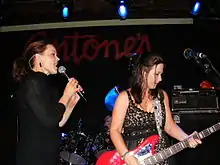
Belinda Carlisle's first venture into punk rock music was in 1977 as drummer for the band the Germs, under the name Dottie Danger.[46] She was recruited into the band by Lorna Doom.[47][48] Soon after leaving the Germs, she co-founded the Go-Go's (originally named the Misfits), with Margot Olavarria, Elissa Bello, and Jane Wiedlin. After Olavarria and Bello's departure from the band the new line-up included bassist-turned-guitarist Charlotte Caffey, guitarist-turned-bassist Kathy Valentine, and drummer Gina Schock.[49]
Other artists
- Alice Bag
- Bush Tetras
- Cherie Currie
- Cherry Vanilla
- Delta 5
- Edith Nylon
- Elli Medeiros
- Essential Logic
- Fatal Microbes
- Gee Vaucher
- Gina Birch
- Jackie Fox
- Jayne County
- Jordan
- Kate Korus (fr)
- Lene Lovich
- Lora Logic
- Lorna Doom
- Marie Currie
- Neo Boys
- Pat Place
- Patricia Morrison
- Pauline Murray
- Penelope Houston
- Phew
- Phranc
- Shanne Bradley
- Suzi Gutsy (fr)
- Tessa Pollitt
- The Dishrags
- The Raincoats
- Vi Subversa
- Vivien Goldman
Lene Lovich

Lene Lovich is an American-born English singer, known for her idiosyncratic vocal style. Although active in 1978 & 1979, much of her success was in the 1980s. Her debut studio album Stateless (1978), which produced the single "Lucky Number". She released two more albums, Flex (1979) and No Man's Land (1982), on Stiff Records. In 1989, she independently released the album March, before her 15-year hiatus. [50]
Kim Gordon
The American bassist and singer, Kim Gordon (born 1953) and her band, Sonic Youth were formed in 1981, establishing her as an important presence in the downtown New York City music scene. She wrote and performed music with Sonic Youth through 2012. Her memoir, Girl in a Band was published in 2015.[51]
Lydia Lunch
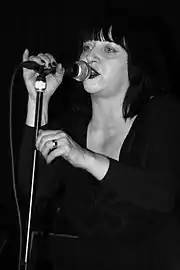
Lydia Lunch (born 1959) is a US punk rock and No Wave singer. Her career was established with the founding of Teenage Jesus and the Jerks in collaboration with James Chance. In the mid-1980s she formed Widowspeak, a recording and publishing company.[52]
Wendy O. Williams
Wendy O. Williams (1949–1998) was the lead singer and songwriter for the punk band, Plasmatics whose performances included such actions as chain-sawing guitars and blowing up equipment on stage.[53]
Debora Iyall
Debora Iyall was the lead singer in the San Francisco-based punk bank, Romeo Void.[54] She was born in Washington state and is of Cowlitz Native American heritage.[55] She is known for her as a skills as a lyricist whose "searing imagery" explores themes like sexuality and alienation from a female perspective.[56]
Shonen Knife

Japanese garage-pop punk band, Shonen Knife, was influenced by the Girl groups of the 1960s.[57] Current members include Naoko Yamano, Ritsuko Taneda, Atsuko Yamano, Risa Kawano, Naru Ishizuka. Former members of the band include Michie Nakatani, Mana Nishiura, Etsuko Nakanishi and Emi Morimoto.
Other artists
- Au Pairs
- Brix Smith
- Beki Bondage, Vice Squad
- Caroline Azar
- Chalk Circle
- Dee Plakas
- Dolly Mixture
- Donita Sparks
- Eve Libertine
- Fifth Column
- Fire Party
- Honey Bane
- Jean Smith
- Jennifer Finch
- Joy De Vivre
- June Miles-Kingston
- Kim Shattuck, The Muffs
- Kira Roessler
- L7
- LiLiPUT (formerly Kleenex)
- Little Annie a.k.a. Annie Anxiety/Bandez
- Marine Girls
- Mia Zapata
- Mo-dettes
- Nina Childress
- Rubella Ballet
- Sara Lee
- Sugar Babydoll
- Suzi Gardner
- The Belle Stars
- The Go-Go's
- The Gymslips
- Vi Subversa
- VulpSS
- Yanka Dyagileva
Riot Grrrl

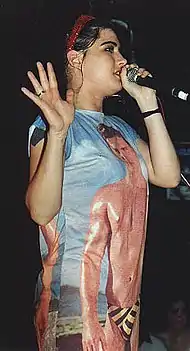

Riot grrrl is an underground feminist hardcore punk movement that originally started in the early 1990s, in Washington, D.C.,[58] and the greater Pacific Northwest, noticeably in Olympia, Washington.[59] It is often associated with third-wave feminism, which is sometimes seen as its starting point. It has also been described as a musical genre that came out of indie rock, with the punk scene serving as an inspiration for a musical movement in which women could express themselves in the same way men had been doing for the past several years.[60]
Riot grrrl bands often address issues such as rape, domestic abuse, sexuality, racism, patriarchy, and female empowerment. Bands associated with the movement include Bikini Kill, Bratmobile, Heavens to Betsy, Excuse 17, Huggy Bear, Cake Like, Skinned Teen, Emily's Sassy Lime, Sleater-Kinney, and also queercore groups like Team Dresch.[61][62] In addition to a music scene and genre, riot grrrl is a subculture involving a DIY ethic, zines, art, political action, and activism.[63] Riot grrrls are known to hold meetings, start chapters, and support and organize women in music.[64]
Some groups that participated in the Riot grrrl movement encouraged men to stand near the back during concerts to allow women their own space near the front.[65] Many members of the punk rock community considered this and other methods of Riot grrrl to be too radical. Due to this, another feminist movement emerged in the East Bay. One group, Spitboy, pushed their feminist values through integration rather than division. They played at venues such as 924 Gilman Street, which banned sexism and sexual harassment.[66]
Kathleen Hanna
Kathleen Hanna (born 1968) and Tobi Vail co-founded the band, Bikini Kill, establishing the feminist riot grrrl movement. Hanna has also released an album under the name Julie Ruin, which developed into Le Tigre.[67]
PJ Harvey
PJ Harvey (born 1969) is an English performers associated with the punk blues and alternative rock genres.[68]
The Breeders
The Breeders are an American band formed in 1990 by Kim Deal of the Pixies, her twin sister Kelley Deal and Tanya Donelly of Throwing Muses. The band has experienced a number of lineup changes; Kim Deal has been the band's sole continual member. Their first album, Pod (1990), though not commercially successful, received wide critical acclaim. The Breeders' most successful album, Last Splash (1993), is best known for the hit single "Cannonball".[69]
Elastica
Elastica were an English band best known for their 1995 album Elastica, which produced singles that charted in the United Kingdom and the United States.[70]
Republica
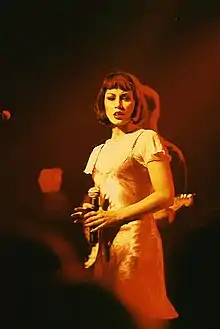
Republica are an English band formed in 1994, featuring their lead singer Saffron. Republica are best known for their hit single, "Ready to Go". Their music is described as dance punk or technopop punk rock.
Hole
Hole was formed in Los Angeles in 1989 by singer and guitarist Courtney Love and lead guitarist Eric Erlandson. The band had a revolving line-up of bassists and drummers, their most prolific being drummer Patty Schemel, and bassists Kristen Pfaff (d. 1994) and Melissa Auf der Maur.[71]
Babes in Toyland
Babes in Toyland (band) is an American punk rock band most active from 1987 to 2001, and reunited from 2014 to the present.[72] Vocalist and guitarist Kat Bjelland, founded the band with drummer Lori Barbero and bassist Michelle Leon. In 1992, Leon was replaced by Maureen Herman. They are best known for their albums, Spanking Machine (1990), Fontanelle (1992) and Nemesisters (1995).[73]
Other artists
- 7 Year Bitch
- Autoclave
- Becca Albee
- Bif Naked
- Christina Billotte
- Corin Tucker
- Fabulous Disaster
- Free Kitten
- Heavens to Betsy
- Huggy Bear
- Janet Weiss
- Jody Bleyle
- Kaia Wilson
- Kat Bjelland
- Katastrophy Wife (fr)
- Lunachicks
- Nomy Lamm
- Quix*o*tic
- Shirley Manson
- Slant 6
- Spitboy
- The Donnas
- Theo Kogan
- Tilt – Cinder Block
Carrie Brownstein
Carrie Brownstein (born 1974) rose to prominence by establishing the riot grrrl all-women punk band Sleater-Kinney with Corin Tucker and Janet Weiss.[74] During the early 2010s, Brownstein and Weiss were members of the band Wild Flag.
Laura Jane Grace
.jpg.webp)
Laura Jane Grace (born 1980) is an American transgender musician who is the founder, guitarist and lead singer, songwriter and of the punk band Against Me![75]
Brody Dalle
Australian-born singer-songwriter and guitarist, leader of The Distillers and spinnerette.
Regina Zernay Roberts
Lead singer/bassist of Méchant and later bassist of Cowboy Mouth and Cee Lo Green's Scarlet Fever.
Hayley Williams
American singer-songwriter, vocalist and keyboardist who is best known for her work with Paramore. She has worked in the male-dominated punk rock genre for a decade before shifting towards the pop-punk and alternative rock genres.[76]
Other artists
Other prominent female punk related artists, bands and individuals from this era include Beth Ditto, Bleach, Holly Brewer, Jemina Pearl, Mika Miko, Nü Sensae, Retching Red, The Bombpops and The Coathangers. The Canadian singer/songwriter Avril Lavigne has been described as pop punk.
2010s
The 2010s saw a considerable increase in numbers of women taking up rock musicianship.[77][78] Accordingly there was a profusion of new female or female-fronted bands on the punk scene.[79]
Pussy Riot
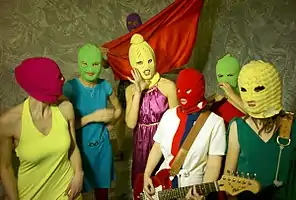
Formed in 2011 as a punk band, artist collective and activist group.[80][81] In addition to their music, the group used public guerrilla performance to convey political messages. These performances were the basis for music videos available online.[82]
Amanda X
Post-punk power pop all-female trio from Philadelphia.[83] Billboard magazine has called them "leaders in their scene" and has described their harmonies as thrash power-pop.[84] They have also received press coverage from Rolling Stone Magazine and The Guardian.[83][85] The band is composed of Melissa Brain on drums, Kat Bean on bass and Cat Park on guitar.[85] Their sound has been compared to Sleater Kinney.[86]
Meredith Graves
Graves is the American frontwoman for the punk rock band Perfect Pussy, which was founded in 2012 in Syracuse, New York.[87][88] In 2015, Graves went on to found the music label, Honor Press, as a feminist gesture to "fight punk's patriarchy.[89][90] She described, in an interview with Ilana Kaplan in New York that her positive experiences making music were inspiration for establishing Honor Press.[91] In the same interview, she cites women visual artists, Jenny Holzer and Barbara Kruger, as well as writers Kathy Acker and Susan Sontag as inspirations.[91]
Louise Distras
Alternative rock singer-songwriter from Wakefield, West Yorkshire.[92][93][81]
The Tuts
English DIY pop punk[94] band from Hayes, London.[95] They have received extensive coverage from alternative music radio, most notably Amazing Radio, and from music websites. They were featured in the ITV series Young, British and Muslim in April 2018.[96]
The SoapGirls
UK-based, French-born, South African-raised sisters Noemie Debray (guitar, vocals) and Camille Debray (guitar, vocals). Three albums released as punk band, multiple press coverage[97][98][99] Previous career as dance-pop act on Universal Records in South Africa, scored number one album and four Top 5 singles on country's music charts.[100]
Lauren Tate
Solo artist and since 2015 lead singer of Hands Off Gretel. an alternative rock/grunge band affiliated to the UK punk scene, formed 2015 in South Yorkshire.[101][102]
Nina Courson
French born, London based lead singer of punk rock/grunge band Healthy Junkies since 2009. They have released five albums, which have received multiple coverage in the press.[103][104]
Puss Johnson
Frontwoman since 2002 of band Pussycat and the Dirty Johnsons. They have released four albums, which have received multiple coverage in the press.[105][106][107]
The Featherz
Welsh/English band with glam and punk influences (self-styled as "Flock Rock") led by Danie Centric (known as Danie Cox prior to January 2018, born 15 December 1990 in Bridgend) on lead vocals and guitar. Cox formed the band with two fellow former members of Georgie Girl And Her Poussez Posse, a band fronted by Georgina Baillie and mentored by Adam Ant.[108] Centric also leads all female Slade tribute band Slady[109] and records with The Lurkers.[110]
Petrol Girls
English punk rock band formed in London in 2012 by Ren Aldridge and Liepa Kuraitė, with Joe York and Zock Astpai joining later. The band is named after the historical Pétroleuses[111][112] and is outspokenly feminist. They have received media coverage.[112][111][113]
The Kut
London-based alternative rock project, assembled by frontwoman and self-taught multi-instrumentalist Princess Maha.[114] They have received extensive radio and music press coverage including from Planet Rock,[114] BBC Introducing,[115] Kerrang!.[116] Debut album Valley of Thorns reached No. 18 in the UK Independent Albums Chart[117]
Barb Wire Dolls
Grunge/punk rock band from Greece, based in the United States. They were championed by Lemmy on whose personal record label (a subsidiary of Warner Music Group) their third and fourth albums were released.[118]
Priests
Post-punk band from Washington D.C. formed in 2012 by Katie Alice Greer (vocals), Daniele Daniele (drums), Taylor Mulitz (bass), and G.L. Jaguar (guitar). Debut LP Nothing Feels Natural on several Best Albums Of 2017 lists including Billboard,[119] NPR,[120] the Atlantic,[121] and Pitchfork.[122] Rolling Stone magazine described the band as "forging jagged incantations that challenge norms ranging from the driving forces of capitalism to punk's own chest-beating macho traditions."[123]
Frau
All-female hardcore feminist punk band from London.[124] Billboard magazine named them one of "20 All-Female Bands You Need To Know".[125] The band also received coverage in Maximumrocknroll[126] and the Guardian.[127]
White Lung
Canadian punk band consisting of Mish Barber-Way (vocals), Kenneth William (guitars) and Anne-Marie Vassiliou (drums).[128]
Fashion
A designer associated with early UK punk fashion in the 1970s was Vivienne Westwood, who made clothes for Malcolm McLaren's boutique in the King's Road, which became famous as "SEX". Other designers included Wendy Gawitz and Kate Buck of "Eccentric Clothing" in Collingwood; Melbourne, Australia designers Julie Purvis and Jillian Burt, and fellow Australians Kate Durham and Sara Thorn.[143]
Women in the hardcore punk scene typically wore army pants, band T-shirts, and hooded sweatshirts.[144] The style of the 1980s hardcore scene contrasted with the more provocative fashion styles of late 1970s punk rockers (elaborate hairdos, torn clothes, patches, safety pins, studs, spikes, etc.).
In 2013 the Metropolitan Museum of Art in New York organized the historical exhibition, PUNK: Chaos to Couture, featuring clothing worn and/or fabricated by punk musicians, as well as designers such as Vivenne Westwood, Rodarte, Ann Demeulemeester, Katharine Hamnett and others.[145] A comprehensive exhibition catalog, designed by Pentagram was produced by the museum, and distributed by Yale University Press.[146]
Social change
The Mexico City-based punk rock collective, Hijas de Violencia (the Daughters of Violence) conduct street performances to combat harassment of women.[147] A precursor was Chavas Activas Punks (CHAP)'s, a women's collective that formed in the Mexico City pun community in 1987. The anthropologist, Maritza Urteaga Castro-Prozo writes of their protests against the "hostility and rejection they experienced from male counterparts." She goes on to write that while they had "little acquaintance with feminist theory" their lyrics and fanzine focused on gender discrimination and sexuality.[148]
Pussy Riot's lyrical themes include feminism, LGBT rights, and government opposition. The collective considers Russian President Vladimir Putin, to be a dictator, and oppose his policies.[149][150]
Some women in punk rock have used their music and lyrics as platforms for feminist ideologies, and to oppose the sexualization of female musicians and societal policing of women's bodies and sexual agency.[151] As early as the 1960s, women in rock were often considered as sex objects and their capabilities and talent were often undermined while male producers were credited for their music.[151] Some women punk and riot grrrl lyrics called for women to challenge the patriarchy and rape culture such as 7 Year Bitch's song Dead Men Don't Rape. Bikini Kill expressed the need for a revolution in pursuit of disrupting the patriarchy, for example their song, Rebel Girl.[152] Some musicians lyrics expressed themes of queer liberation as in Gossip's Where the Girls Are.[152] Conventional expectations of women's roles were challenged, for example, in The Slits' Typical Girl, that sarcastically addressed stereotypes of women as being "too emotional".[153] Riot grrrl artists and their punk predecessors not only fought for women, but for the LGBTQIA+ community, animal rights, and human rights in general.[152] Queer individuals are present in the punk scene, not only for the music, but possibly because of the solidarity brought about by feeling like outcasts, living on the fringes of society. Punk, as non-normative as it has traditionally been, has (in some cases) become a safe haven for many unaccepted individuals, including queer people. Punks and the punk lifestyle are often outside of the realm of normative culture, and the same can be said for queer individuals.[154] The discomfort in this outcast identity may bring feelings of solidarity for people in punk scenes, queer and otherwise.[154]
See also
References
- Coon, Caroline (1977). 1988: The New Wave Punk Rock Explosion. London: Omnibus/Hawthorne Books. ISBN 978-0801561290.
- Berman, Judy (8 August 2011). "15 Essential Women Punk Rock Icons". Flavorwire. Retrieved 25 November 2015.
- "Why Women in Punk?". Women in Punk. Punk77.co.uk. Retrieved 26 November 2015.
- Raha, Maria (2004). Cinderella's Big Score: Women of the Punk and Indie Underground. Seal Press. ISBN 978-1580051163.
- Reddington, Helen (2012). The Lost Women of Rock Music: Female Musicians of the Punk Era. Ashgate/Equinox Publishing. ISBN 978-1845539573. Retrieved 26 November 2015.
- Woronzoff, Elizabeth. "The Lost Women of Rock Music' Is an Important Work, But a Replay of the Same Old Themes". Pop Matters. Retrieved 26 November 2015.
- Conference proceedings (September 2001). "No Future?". University of Wolverhampton.
- Reddington, Helen (1977). Introduction: The Lost Women of Rock Music (PDF). London: Ashgate. ISBN 9780754657736.
- Lydon, John (1995). Rotten: No Irish, No Blacks, No Dogs. London: Coronet. p. 378. ISBN 978-0312428136.
- George-Warren, Holly (13 November 1997). "Q&A: Chrissie Hynde". Rolling Stone. Retrieved 22 December 2015.
- Hall, Rock. "Women Who Rock: 10 Essential Punk Songs". The Rock & Roll Hall of Fame Museum. Retrieved 27 November 2015.
- Petridis, Alexis. "The Slits' Viv Albertine on punk, violence and doomed domesticity". The Guardian. Retrieved 27 November 2015.
- Andrews, Charlotte Richardson (3 July 2014). "Punk has a problem with women. Why?". The Guardian. Retrieved 27 November 2015.
- O'Meara, Caroline (2003). "The Raincoats: breaking down punk rock's masculinities". Popular Music. 22 (3): 299–313. doi:10.1017/s0261143003003209. JSTOR i371782.
- Julian Schaap and Pauwke Berkers. "Grunting Alone? Online Gender Inequality in Extreme Metal Music" in Journal of the International Association for the Study of Popular Music. Vol.4, no.1 (2014) p. 102
- Julian Schaap and Pauwke Berkers. "Grunting Alone? Online Gender Inequality in Extreme Metal Music" in Journal of the International Association for the Study of Popular Music. Vol.4, no.1 (2014) p. 104
- White, Erika (2 January 2015). "Music History Primer: 3 Pioneering Female Songwriters of the '60s | REBEAT Magazine". Rebeatmag.com. Retrieved 20 January 2016.
- Becker, Shannon (Spring 2012). "Editor's Note: "The World's a Mess It's in My Kiss": Punk Women and Why They Matter.". Routledge – via EBSCO Academic Search Complete
- Leblanc, Lauraine (1999). Pretty in Punk: Girl's Gender Resistance in a Boy's Subculture. Rutgers University Press. ISBN 0813526515.
- Raha, Maria (2004). Cinderella's Big Score: Women of the Punk and Indie Underground. Seal Press. ISBN 1580051162.
- Auslander, Philip (28 January 2004). "I Wanna Be Your Man: Suzi Quatro's musical androgyny" (PDF). Popular Music. United Kingdom: Cambridge University Press. 23 (1): 1–16. doi:10.1017/S0261143004000030. Archived from the original (PDF) on 24 May 2013. Retrieved 25 April 2012.
- Brake, Mike (1990). "Heavy Metal Culture, Masculinity and Iconography". In Frith, Simon; Goodwin, Andrew (eds.). On Record: Rock, Pop and the Written Word. Routledge. pp. 87–91.
- Walser, Robert (1993). Running with the Devil:Power, Gender and Madness in Heavy Metal Music. Wesleyan University Press. p. 76.
- Eddy, Chuck (1 July 2011). "Women of Metal". Spin. SpinMedia Group.
- Kelly, Kim (17 January 2013). "Queens of noise: heavy metal encourages heavy-hitting women". The Telegraph.
- "Patti Smith". Rock and Roll Hall of Fame Museum. Retrieved 25 November 2015.
- Bockris, Victor; Bayley, Roberta (1999). Patti Smith: an unauthorized biography. Simon and Schuster. p. 19. ISBN 978-0-684-82363-8.
- Light, Alan (3 October 2008). "Her City's Not Gone, and Neither is She". The New York Times. Retrieved 25 November 2015.
- Savage, Jon (June 1986). "High Priestess". Spin. Los Angeles, California: SpinMedia. p. 66. Retrieved 4 January 2020.
- Metzger, Richard. "Pre-punk Nina Hagen in East Germany, 1974". Dangerous Minds. Retrieved 25 November 2015.
- Schönauer, Walter (2011). Nina Hagen: Bekenntnisse (Confessions). Munich, Germany: Pattloch Verlag. ISBN 978-3-629-02272-1.
- Facroski, Kelli Skye (21 August 2013). "Exene tells it straight on X, illness and O.C." The Orange County Register. Retrieved 25 November 2015.
- Popson, Tom (7 October 1988). "Top 10 Again, Joan Jett Looks at the State of Rock". Chicago Tribune. Retrieved 25 November 2015.
- "Lydia Lunch Through the Years". New York Times. Retrieved 4 January 2020.
- Nissim, Mayer. "Punk star Poly Styrene dies, aged 53". Digital Spy. Retrieved 4 January 2020.
- Robb, John (21 October 2010). "Ari Up obituary: The Slits frontwoman, she helped to reinvent women's role in music". The Guardian. Retrieved 25 November 2015.
- Kreps, Daniel (21 October 2010). "Ari Up, of the Punk Band the Slits, dies at 48". Rolling Stone. Retrieved 25 November 2015.
- Strong, M.C. (2003). The Great Indie Discography. Edinburgh: Canongate Books. ISBN 978-1-84195-335-9.
- Larkin, Colin (2002). The Virgin Encyclopedia of 70s Music. London: Virgin Books. ISBN 978-1-85227-947-9.
- Gallix, Andrew (2005). "Untypical Girl". 3:AM Magazine. Retrieved 9 December 2015.
- Berger, Melody (2014). "The Pilgrimage of Palmolive". Tom Tom Magazine. Special Issue on Spirituality and Religion (February 2014). Retrieved 9 December 2015.
- Garry Mulholland (December 2006). "Aloha from hell! The grave tale of a dead serious rock'n'roll band". The Stool Pigeon. Thestoolpigeon.co.uk. Archived from the original (Article) on 5 February 2012. Retrieved 7 May 2012.
- Pius (23 February 1992). "Poison Ivy 1992 Interview" (Interview). PENETRATING INSIGHTS. Nonozeroblog.blogspot.com. Retrieved 7 May 2012.
- "Blondie Biography". Rock and Roll Hall of Fame Museum. Retrieved 25 November 2015.
- Parkhouse, Will (25 February 2010). "I Do Not Believe In Love: Viv Albertine On Life Post The Slits". The Quietus. Retrieved 18 July 2017.
- Bag, Alice (2 September 2011). Violence Girl: East L.A. Rage to Hollywood Stage, a Chicana Punk Story. Feral House. pp. 185–6. ISBN 978-1-936-23913-9.
- Spitz, Marc; Mullen, Brendan (2010). We Got the Neutron Bomb: The Untold Story of L.A. Punk. Crown/Archetype. p. 67. ISBN 978-0-307-56624-9.
- Mullen, Brendan; Bolles, Don; Parfrey, Adam (2009). Lexicon Devil: The Fast Times and Short Life of Darby Crash and The Germs. Feral House. p. 43. ISBN 978-1-932-59555-0.
- "The Go-Go's". Rolling Stone. Biography. Archived from the original on 20 December 2015. Retrieved 19 September 2017.
- Juneau, Jason. "Innovation in New Wave: Lene Lovich", Perfect Sound Forever, September 2001.
- Hyman, Dan (12 September 2013). "Q&A: Kim Gordon on Her New Bankd Body/Head and Missing Sonic Youth". Rolling Stone. Retrieved 25 November 2015.
- Calhoun, Ada (20 December 2013). "Lydia Lunch Through the Years". The New York Times. Retrieved 25 November 2015.
- Strauss, Neil (9 April 1998). "Wendy O. Williams, 48, Star of Explosive Punk Rock Act". The New York Times. Retrieved 25 November 2015.
- Evans, Kirsty. "Debora Iyall Fills a Void". East Bay Express. East Bay Express. Retrieved 12 February 2016.
- Lanham, Tom (10 June 2011). "Debora Iyall from Romeo Void is back with 'Stay Strong'". San Francisco Examiner. Retrieved 13 February 2016.
- Mason, Stewart. "Romeo Void biography". AllMusic. All Media Network. Retrieved 21 February 2011.
- Murther, Christopher (9 March 2005). "Shonen Knife Makes Its Point With Positive Punk". Boston Globe. The New York Times Company. Retrieved 9 March 2005.
- Kaye, Deirdre (9 April 2015). "Boston wins 'Most Feminist City' with Riot Grrrl Day — we made a playlist to celebrate".
- Feliciano, Steve. "The Riot Grrrl Movement". New York Public Library.
- Marion Leonard. "Riot grrrl." Grove Music Online. Oxford Music Online. Oxford University Press. Web. 20 July 2014.
- "List of Riot Girl Bands". Hot-topic.org. Archived from the original on 23 February 2009. Retrieved 30 September 2012.
- Meltzer, Marisa (15 February 2010). Girl Power: The Nineties Revolution in Music. Macmillan. p. 42. ISBN 9781429933285.
- Jackson, Buzzy (2005). A Bad Woman Feeling Good: Blues and the Women Who Sing Them. New York: W.W. Norton. ISBN 978-0-393-05936-6.
- Schilt, Kristen (2003). ""A Little Too Ironic": The Appropriation and Packaging of Riot Grrrl Politics by Mainstream Female Musicians" (PDF). Popular Music and Society. 26 (1): 5. doi:10.1080/0300776032000076351. S2CID 37919089.
- Dunn, Kevin (March 2012). "We ARE the Revolution": Riot Grrrl Press, Girl Empowerment, and DIY Self-Publishing". Hobart and William Smith Colleges, Geneva: 156 – via EBSCO.
- Redford, C. (Director). (2017). Turn It Around: The Story of East Bay Punk [Motion picture]. United States: Abramorama.
- Frere-Jones, Sasha (26 November 2012). "Hanna and Her Sisters". The New Yorker. Retrieved 25 November 2015.
- "PJ Harvey wins Mercury Prize for second time". BBC News. Retrieved 25 November 2015.
- Aaron, Charles (March 1994), "Ordinary People", Spin, 9 (12): 82
- Erlewine, Stephen Thomas. Elastica > Biography at AllMusic. Retrieved 4 June 2016.
- Harding, Cortney (2 April 2010). "Courtney Love: Fixing a Hole". Billboard. Retrieved 21 October 2013.
- Barton, Laura (22 February 2015). "Babes in Toyland: 'Our reunion is all about the friendship'". The Guardian. Retrieved 24 November 2015.
- Schoemer, Karen (27 March 1992). "Pop/Jazz; Post-Punk Angst of Babes in Toyland". The New York Times. Archived from the original on 7 December 2010. Retrieved 4 November 2017.

- Kreps, Daniel (15 March 2014). "Carrie Brownstein Pens Memoir 'Hunger Makes Me a Modern Girl'". Rolling Stone. Retrieved 25 November 2015.
- Gross, Terry (4 April 2017). "For Laura Jane Grace, Punk Was A Form Of Armor". National Public Radio. Retrieved 18 July 2017.
- Ganz, Caryn (4 March 2020). "How Hayley Williams Saved Herself (and, BTW, Paramore)". The New York Times. Retrieved 13 October 2020.
- Roisin O'Connor (18 October 2018). "Half of all new guitar players are women, finds study". The Independent. Retrieved 8 January 2019.
- John Harris (23 October 2018). "For rock music to survive it will have to cut back on testosterone". The Guardian. Retrieved 8 January 2019.
- Turnball, Bruce. "'There is also a strong movement of bands with girls and it is very refreshing to see, it gives new life to the scene' – Nina Courson, lead singer of Healthy Junkies". Vive Le Rock issue 61 p35.
- Nocera, Joe (7 February 2014). "Pussy Riot Tells All". The New York Times. Retrieved 28 September 2016.
- Snapes, Laura (21 August 2012). "Have Pussy Riot sparked a new wave of grrl power?". The Guardian. Retrieved 4 January 2020.
- Langston, Henry (12 March 2012). "Meeting Pussy Riot". Vice. Retrieved 4 January 2020.
- Nelson, Brad (22 October 2014). "CMJ's opening night: Amanda X, Dune Rats, J Fernandez, Charly Bliss, Roomrunner". The Guardian. Retrieved 18 July 2017.
- Sherman, Maria. "20 All-Female Bands You Need to Know". Billboard. Retrieved 18 July 2017.
- Grant, Sara. "10 New Artists You Need to Know: September 2014". Rolling Stone Magazine. Retrieved 18 July 2017.
- Ambrosio, John. "Amanda X, Amnesia (review)". Impose. Retrieved 18 July 2017.
- Minsker, Evan (30 October 2013). "Perfect Pussy". Pitchfork. Retrieved 18 January 2020.
- Hughes, Hilary (25 February 2015). "Perfect Pussy's Meredith Graves on Her New Label, Honor Press: 'No Snobs, No Phonies, No Shitheads'". Village Voice. Retrieved 14 July 2016.
- Hughes, Hilary (25 February 2015). "Perfect Pussy's Meredith Graves on Her New Label, Honor Press: 'No Snobs, No Phonies, No Shitheads'". Village Voice. Retrieved 18 January 2020.
- Garland, Emma (3 June 2015). "Perfect Pussy's Meredith Graves: taking the feminist fight to punk's patriarchy". The Guardian.
- Kaplan, Ilana (30 April 2015). "Meredith Graves on Powerful Punk and Her Own Label". New York Magazine. Retrieved 15 July 2016.
- "Louise Distras Premieres New Single, Aileen". Kerrang!.
- "Louise Distras 'Songs From The Factory Floor' : album review – Louder Than War". 29 August 2013.
- Dave Chrzanowski (5 March 2017). "Introducing The Tuts". Songwriting Magazine. Retrieved 8 January 2019.
- "The Tuts Interview: "It is literally DIY or die and we don't wanna die!" – Overblown". 27 February 2016. Retrieved 6 June 2016.
- ITV News (25 April 2018). "Changing what it means to be Young, British and Muslim – ITV News" – via YouTube.
- The Soap Girls New Music profile by Alice Clarke, Planet Rock magazine, February 2020 p16
- The Soap Girls Society's Rejects album review by Hugh Guiland, Vive Le Rock, Issue 47 p91
- Alexandra Hawkins (13 August 2017). "The Soap Girls Interview". Louder Than War. Retrieved 4 January 2020.
- Portland Arms (3 August 2016). "The Soap Girls". Portland Arms. Retrieved 9 January 2020.
- Hands Off Gretel Burn The Beauty Queen album review by Ged Babey, Louder Than War, 18 September 2016
- Hands Off Gretel live review from The Great British Alternative Festival 2018 accompanied by full page photograph of singer Lauren Tate, Vive Le Rock, Issue 58 pp102-103
- Healthy Junkies The Lost Refuge album review, Vive Le Rock, Issue 16 page 87 (link to online version)
- Healthy Junkies interview and Box Of Chaos album review by Craig Chaligne, Louder Than War, 19 February 2016
- Ged Babey (13 February 2013). "Pussycat and the Dirty Johnsons: Dirty Rock'n'Roll – album review". Louder Than War. Retrieved 8 January 2019.
- "Neil Duncan heads to The Haunt in Brighton to see Basingstoke's Pussycat and the Dirty Johnsons in action". Basingstoke Gazette.
- Dirty Rock N Roll album review, Vive Le Rock magazine 2013
- Outrageous dressing Welsh singer Danie Cox teams up with 80s legend Boy George Wales On Sunday 9 January 2014 page 10
- "Gig Review: Slady/The Hoodniks, The Prince Albert, Saturday 2nd June 2019". Plugged in Brighton. 15 July 2019.
- "The Lurkers: High Velocity -new single – Pete Stride, Nigel Moore & Esso reclaim the name..." 22 October 2017.
- "Petrol Girls For Fans Of: Against Me!, Fugazi, Muncie Girls". Kerrang!. London: Wasted Talent Ltd. 3 May 2017. Retrieved 16 March 2018.
- Dedman, Remfry (15 November 2016). "Petrol Girls – Talk of Violence: Exclusive Album Stream". The Independent. London: Independent Print Limited. Retrieved 16 March 2018.
- Knox, Ron (19 January 2016). "Petrol Girls Singer Ren Aldridge Reflects on Visiting Displaced Residents in the Calais "Jungle"". Noisey. Vice Media. Retrieved 16 March 2018.
- Scott Colothan (16 May 2018). "Ones To Watch: The Kut". Retrieved 8 January 2019.
- BBC.co.uk. "BBC Introducing in Lancashire, radio broadcast transmitted BBC Radio Lancashire 16 July 2016 (Link to captioned studio image of The Kut in radio studio)". Retrieved 8 January 2019.
- "Kerrang Record Store Day Article".
- "Official Independent Albums Chart Top 50 – Official Charts Company". www.officialcharts.com.
- Richter, Alison (2012) "Interview: Barb Wire Dolls Guitarist Pyn Doll on the Return of Punk", Guitar World, 7 February 2012. Retrieved 23 February 2013
- Lipshutz, J. (12 December 2017). "Billboard's 50 Best Albums of 2017: Critics' Picks". Billboard.
- Lorusso, Marissa (12 December 2017). "The 50 Best Albums Of 2017". NPR. Retrieved 11 May 2018.
- Kornhaber, Spencer (12 December 2017). "The 10 Best Albums of 2017". The Atlantic.
- "The 50 Best Albums of 2017". Pitchfork. 12 December 2017.
- Mejia, Paula (27 January 2017). "How D.C. Protest-Punks Priests Are Fighting Fascism on Their Own Terms". Rolling Stone.
- Myint, Ava (12 August 2015). "FRAU, "MIRA"". Impose Magazine. Retrieved 18 July 2017.
- Sherman, Maria (6 March 2015). "20 All-Female Bands You Need To Know". Billboard Magazine. Retrieved 18 July 2017.
- Layla (23 September 2014). "Record of the Week: FRAU Punk Is My Boyfriend EP". Maximumrocknroll. Retrieved 18 July 2017.
- Bakare, Lance (20 November 2014). "From Bad Brains to Cerebral Ballzy: why hardcore will never die". The Guardian. Retrieved 18 July 2017.
- Kaplan, Ilana (22 July 2016). "White Lung's Mish Barber-Way Talks Matrimony And Finding Her Own Paradise". papermag.com. Retrieved 4 August 2016.
- "7 of the best rising bands under 21". Alternative Press Magazine.
- Jeff Moses. "10 Best Bands and Musicians in Phoenix Under the Age of 21". Phoenix New Times.
- Glenn BurnSilver. "Doll Skin is Phoenix's Most Exciting Teen Rock Band – Phoenix New Times". Phoenix New Times.
- Bobby Olivier (4 October 2018). "The 10 Bands You Need to Know About for This Year's Festival Season". Billboard.com. Retrieved 31 December 2018.
- Maid Of Ace Maid In England album review by Ged Babey, Louder Than War, 31 July 2016
- Maid Of Ace Rebellion Festival 2017 live review with photograph, Vive Le Rock Issue 47 pp 80–81
- dragSTER Anti-Everything album review by Mark Ray Louder Than War, 27 July 2018
- dragSTER feature/interview with Fi Dragster by Paula Frost, Vive Le Rock, Issue 57 pp67-68
- Kerrang! (14 March 2017). "IDestroy premiere Video for Annie". Kerrang.com. Retrieved 20 January 2019.
- Ged Babey (25 February 2018). "IDestroy – video for Lemons and UK tour dates (with The Men That Will Not Be Blamed For Nothing)". louderthanwar.com. Retrieved 20 January 2019.
- http://www.skruttmagazine.se/bolokoseng.htm
- https://www.rci.fm/guadeloupe/infos/Culture/Bolokos-veritable-succes-pour-les-guadeloupeens-au-festival-anglais-Rebellion
- Angie Needham (17 September 2018) "Maltese post-punk band Cryptic Street Don't Need No Men" DIVA Magazine Accessed 8 January 2019
- Matthew Agius (30 May 2018), 4:23 pm Girl band left heartbroken after equipment theft, Malta Today Accessed 8 January 2019
- "Punk a Photographic Journey The History of the Melbourne Punk Scene". www.punkjourney.com.
- Brockmeier, Siri C. "Not Just Boys' Fun?" The Gendered Experience of American Hardcore. Available online at: https://www.duo.uio.no/bitstream/handle/10852/26264/BrockmeierxDUO.pdf?sequence=1 Accessed on 4 January 2016
- Ryzik, Melena (25 April 2013). "Haute Punk". The New York Times. Retrieved 30 December 2018.
- Bell (ed.), Eugenia (2013). PUNK: Chaos to Couture. New York: Metropolitan Museum of Art. ISBN 978-1-58839-489-7. Retrieved 30 December 2018.CS1 maint: extra text: authors list (link)
- De La Torre, Anna Paula. "Las hijas de Violencia: con punk y performance combaten el acoso callejero en México". pijamasurf.com. PijamaSurf. Retrieved 28 January 2016.
- Marciniak, Marta (2015). Transnational Punk Communities in Poland: From Nihilism to Nothing Outside Punk. Lexington Books. pp. 168–169. ISBN 9781498501583. Retrieved 9 December 2019.
- Carole Cadwalladr (29 July 2012). "Pussy Riot: will Vladimir Putin regret taking on Russia's cool women punks?". The Observer. London. Retrieved 20 November 2012.
- Oleg Kashin (17 August 2012). "Putin's message: if you're pro Pussy Riot you're against the Orthodox church". The Guardian. London. Archived from the original on 18 November 2012. Retrieved 10 November 2012.
- Daugherty, R. (2002). The spirit of '77: Punk and the girl revolution. Women & Music – A Journal of Gender and Culture, 6, 27FF-27FF.
- Mcdonnell, E., & Vincentelli, E. (2019, ). Feminism + punk: Arts and leisure desk. New York Times
- Nguyen, M. T. (2012). "Making waves: Other punk feminisms". Women & Performance: A Journal of Feminist Theory. 22 (2–3): 355–359. doi:10.1080/0740770X.2012.720895. S2CID 194103788.
- Sharp, M.; Nilan, P. (2017). "Floorgasm: Queer(s), solidarity and resilience in punk". Emotion, Space and Society. 25: 71–78. doi:10.1016/j.emospa.2017.06.005.
External links
- The Lost Women of Rock Music
- Women in Punk A-Z
- Women of Punk and Post Punk Music at Biography.com
- The Story of Feminist Punk in 33 Songs Pitchfork


